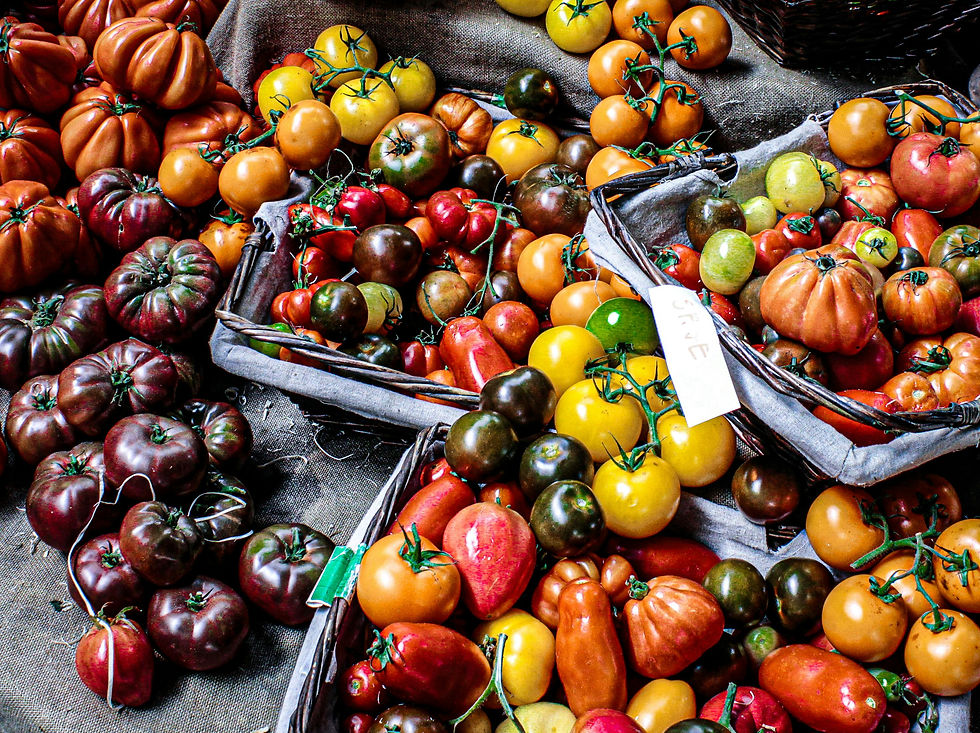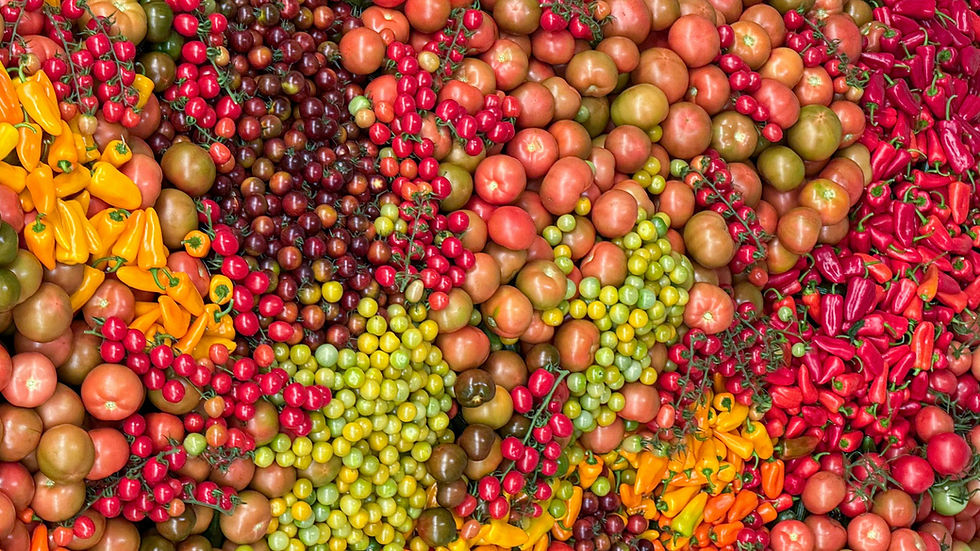Heirlooms and Hybrids: Dissecting the Tomato
- Friends of Sustainable Agriculture

- Aug 26
- 3 min read
The most common categories for tomato shopping usually refer to their general shape and purpose. You might get cherries, in different sizes and colors but generally bite sized, plum tomatoes are beloved because their firm pulp lends itself beautifully for pastes and sauces, and beefsteak tomatoes, large and firm enough to slice and eat in big slabs.

But there is a more obscure category that seems to be everywhere this days. Walk past a tomato display and you might hear someone ask, “Are these heirlooms?” The answer often carries weight, as if whispered in reverence. But what exactly does “heirloom” mean, and why are these tomatoes so coveted?
What Makes a Tomato an Heirloom?
Heirloom tomatoes are open-pollinated varieties that have been passed down through generations, often within families or communities—or just tomatoes, until a few decades ago. To understand their existence, we need to talk about hybrids. Intentionally bred for specific qualities allowing for convenience and mass production, such as uniformity, pest resistance or shelf stability, most conventionally grown vegetables in our stores are hybrids.

Hybrid varieties brought along the standardization of produce and agribusiness ventures. As companies modified their seeds, those became proprietary, which means that current hybrid seeds are almost always non-fertile and must be bought to plant before every season.
The concept of heirlooms, thus, is not that old. Rather, it came to be by the mid-20th century, when people started to recognize that things had changed with the industrialization of food production and slowly gained traction until becoming a staple of foodies and marketgoers.
People are enticed by the diversity, the very appealing colors and the fact that no two heirlooms look quite the same. Some are lumpy, others ribbed; they come in hues from deep maroon to ghostly white, golden yellow to green striped. Furthermore, because of their prior existence in a particular spot, heirlooms tend to be more genetically diverse and regionally specific. Their seeds carry stories—of Appalachian homesteads, Midwest farmsteads, or a Sicilian great-grandmother’s kitchen garden.

The Heirloom Debate: What Counts?
There’s some debate in the gardening world about what qualifies as a true heirloom. Some folks draw the line at 50 years old, around the time that hybrids became common. Others require that variety have a traceable history or cultural significance. Then there’s the question of whether commercial varieties that are simply old can count, or if it must be a family-kept seed.
In all cases, most of the varieties that are considered heirloom today were naturally hybridized in the 19th century, around the time that farmers and botanists in America first became enticed by the fruit. While the definition remains fuzzy, what most agree on is the value: heirlooms preserve biodiversity, flavor profiles, and local food culture in a way few other things do.

Why Tomatoes Became the Heirloom Icon
Tomatoes are arguably the poster child for heirloom produce because of how dramatically their appearance and flavor shift from conventional to heirloom. Rich, tangy, sweet, and often layered in a way that uniform supermarket tomatoes simply aren’t, the contrast is easy to taste, especially in peak season. Their short growing window and fragility make them prized but fleeting treasures. Many heirloom varieties are too delicate to travel far, which is why farmers markets are often the best places to find them.
However, they are not the only ones. Heirloom beans like Jacob’s Cattle or Tiger Eye are treasured for their unique patterns and cooking qualities. Heirloom apples—from Arkansas Black to Ashmead’s Kernel—offer flavors far beyond the Red Delicious. Squash, corn, lettuces, and even herbs have heirloom strains cherished for both culinary and cultural reasons.
Each variety tells its own story, often tied to a place and a people. In a world rushing toward uniformity, these plants stand as quiet acts of resistance: expressive, and alive with character. If you find them on your next visit to the farmers market: try them! They might look different than what you are used to, and the flavor will surely surprise you.
Did you know?
Beyond hybrids—GMOs. Taking it one step further, a tomato was the first genetically modified vegetable that the FDA-approved for sale in the United States. If you are over 40, you might recall the Flavr Savr. Launched in 1994, it was engineered to “save” its original flavor while ripening more slowly. However, high costs, public mistrust, and its unexpected blandness resulted in it being pulled from the shelves only three years later.




Comments